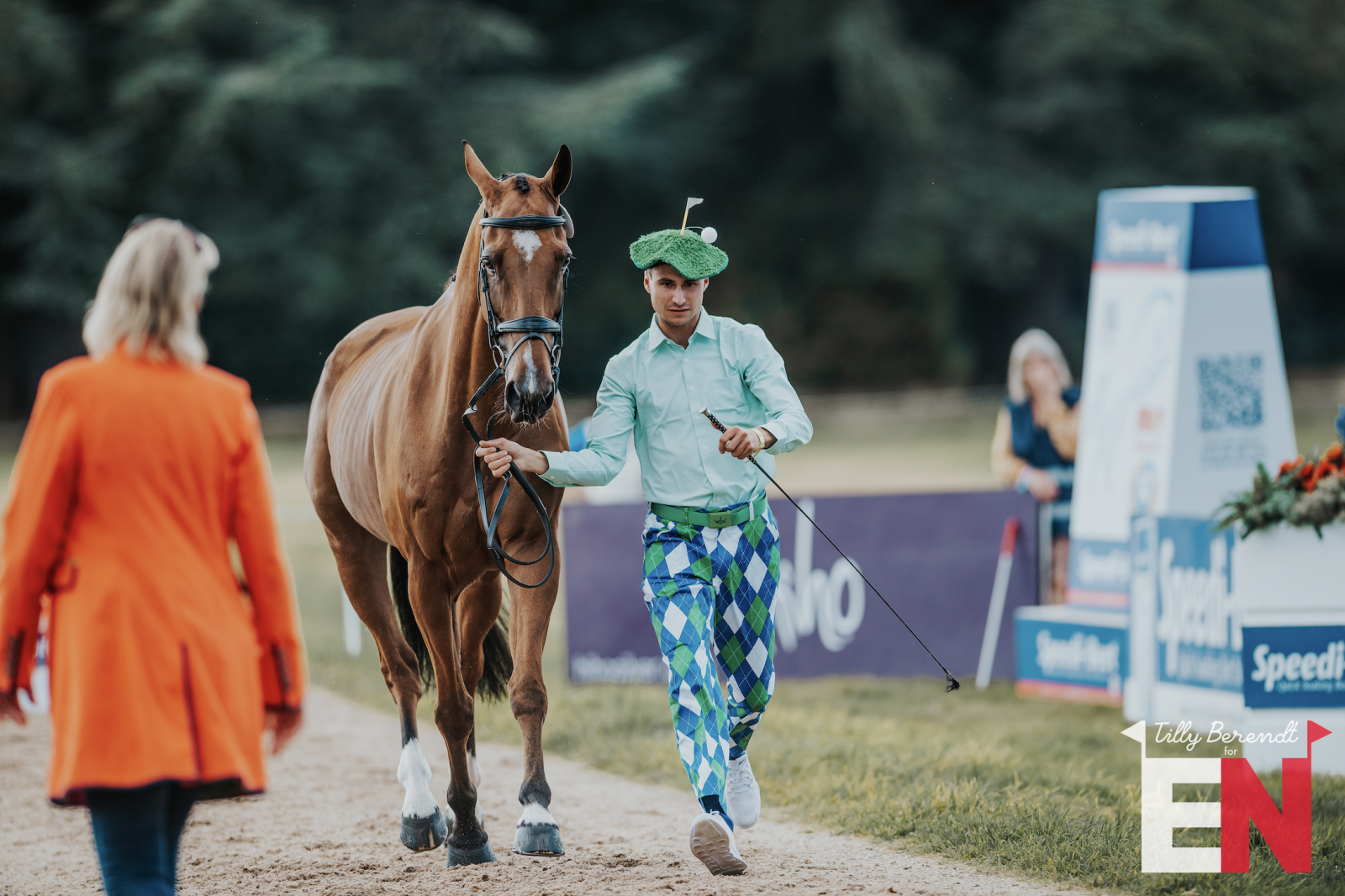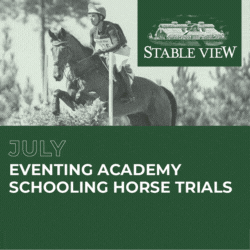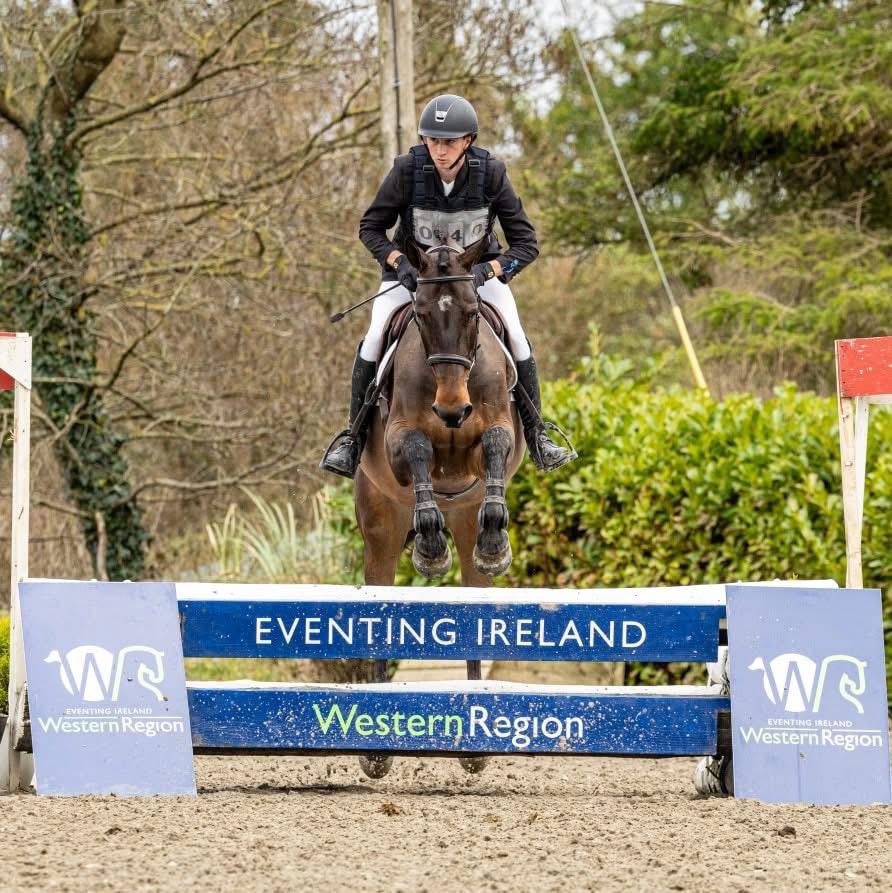It seems like these days we look at each other’s lives through the lens of a highlight reel. We get to see the incredible trips, the best jumps, and the moments that we’re proud enough of to put on social media. What we don’t talk about is how much pressure this adds to athletes on both ends of the news feed.
Riders, whether professional or not, are made to feel like they ‘have to’ post something that makes them look cool and successful. Then, as we consume this content, we are stuck with the disillusioned perception that the sport is easy and that if you’re not succeeding, then maybe you aren’t cut out for it. I would like to take this opportunity to go ‘between the ears’ of some of the riders that make up our Eventing Nation and work to understand some of the real challenges this industry presents.
To read more from the Between the Ears series, click here.

Courtney Cooper and Who’s A Star. Photo by Leslie Threlkeld.
On this edition of Between the Ears, I spoke with Courtney Cooper, owner of C Square Farm and the USA partner of Excel Star Sporthorses. A 5* rider in her own right, Courtney has also made a life and business of selling horses, which I think we can all agree is no easy feat. If you are shopping for a new partner, there is a pretty good chance someone has told you to “see what Courtney has”, given that she can have up to 20 quality horses for sale in her barn at any time.
I had the chance to talk to Courtney about how she manages to balance sales with her career and some of the hurdles that she has faced in this side of the industry.
Can you tell me about how you started your career in eventing and how you decided to make sales the focus of your business?
I started riding when I was 12 at NCMT, New Canaan Mounted Troop, in New Canaan, CT, which was based on the tenets of the Calvary system; similar to Pony Club. The focus at NCMT was Eventing, so that’s how I got into the sport.
When I got to college, I wanted to keep riding but my parents said ‘no’ unless I paid for it and maintained a ‘B+’ average in school, so that’s what I did; I attended Rice University in Houston and started a career in sales to pay for horses. I sold Cutco knives throughout college and was very successful at it, and when I graduated I started selling insurance for Northwestern Mutual Life Insurance.
Horses continued to be a part of my life at the amateur level, and I was riding with Bruce Davidson Sr., living in Georgia, and Bruce told me if I wanted to do horses full time, I needed to move to Unionville or Middleburg. I didn’t know anyone in Middleburg, so that’s how I ended up where I am now.
In the beginning, I was sort of just buying and selling horses myself, and my business grew naturally from there. I imported horses from Ireland, did consignment sales, and even started breeding. In 2016, I was able to take my very first homebred, Who’s A Star (Tag), to complete the Kentucky 5*. The next year, I took Tag back to Kentucky, and we weren’t as successful. Sitting around after cross country, I started to think a bit more about how to make this sport work.
I’ve never really been in a position to have owners and sponsors who are paying the bills on a competition horse. So I went back to Ireland, where I’ve always felt comfortable, to try to figure out something sustainable. 18 months later, Excel Star Sport Horses was created with my overseas partners. Now we import about 40 to 50 Irish horses a year to sell and compete, and I can have a few horses to compete myself as well.

Courtney Cooper and Who’s A Star. Photo by Leslie Threlkeld.
How has your business model affected your confidence in your riding throughout the years?
When I first started my consignment business, I would pretty much take anything as long as it wasn’t dangerous or lame, because I truly believe that every horse has a place. That being said, taking in horses where you feel like you are just fixing problems is tough. You can use the same methods of training you’ve been successful with for many other horses, and sometimes it just doesn’t work because of the baggage that the horse carries with it.
Now that my business is focused more on young Irish horses than consignments, I struggle with the lack of consistency that is inherent with a young horse. Some days, things click into place, and it feels amazing. Then the next day, on the same horse, it feels like the wheels are falling off the bus, and you don’t know what you’re doing.
I am lucky to have good partners that I work with overseas, and if they have a horse that isn’t suited to my market, they won’t put the horse on a plane to come over; unfortunately horses are horses so we occasionally, run into problems. Sometimes horses don’t ship well, and as a result, they regress in their training before you can make any progress. So some horses take longer to produce than others.
I’ve also had my fair share of injuries, but for me, the biggest knock to my confidence is when my training methods ‘should’ be working, but the results just aren’t showing in our performance.
I feel like a lot of people stray away from sales because they find it difficult to sell a horse after developing a relationship with the animal. Do you ever deal with these feelings?
The hardest horses for me to sell are my personal horses. For instance, right now, I have a very competitive eight-year-old, Excel Star Tick Tock. She’s a winner through the preliminary level and will likely continue to move up, and we adore her. She’s been in my program since she was a four-year-old. And, so, when someone comes and tries a horse like her, I take things a little more personally because I have done all the work to get her where she is today, and she is a member of the family.
There have certainly been times when I wish I had someone like me that I could send my horse on to and have them sell the horse for me, because it’s hard, when there are emotions involved. That being said, most of the horses that I have in, specifically to sell, I don’t have for very long, so I don’t struggle so much with finding them homes on an emotional level. I do, however, keep up with the horses I sell, regardless of how short a time they are in my barn. I created a private Facebook page for my clients to keep up with me and each other, to celebrate successes on the horses, share their journey, and also get support for any roadblocks that they may face in horse ownership.

Courtney Cooper and Excel Star First Class. Photo by Shelby Allen.
What do you think is the hardest challenge that you face in the industry?
I think the hard thing is that a lot of people choose to not use a dealer or someone who sells a lot of horses because of the risk of being scammed. I always thought that the fact that I sell a lot of horses was a benefit to use someone like me. I have an incentive to want to sell quality horses and to be honorable in the sale.
When someone only has one horse to sell, their reputation isn’t riding on the sale of that horse. Whereas for me, my reputation is made with every horse that I sell. I am not saying there are not people who don’t take advantage of the fact that they sell a lot of horses either, and people need to do their homework.
From the early days of my consignment business, when I was taking a lot of horses that had previous bad experiences, I always made sure I was very upfront with people regarding the horses’ strengths and limitations. Honesty is always my priority. I now bring over a lot of Irish horses, and not every one of them is an upper-level prospect. A lot of them are just kind, good-quality animals that are going to bring someone a lot of joy and happiness.
I like to be open and always give vet records, and some professionals have told me they will never do business with me because of that. I want to be fair and transparent and make sure the animal goes to a place where he or she will be successful if they have limitations.
Buying and selling horses is a difficult and emotional process. I don’t think it’s my job to sugarcoat everything and make people believe that the horse they “love” when they try it is their “heart” horse. Unfortunately there are others in the industry that do that, in order to make a sale, and that’s when inappropriate partnerships may be made.
Personally, if I sell a horse that doesn’t work out, I will do my best to make the situation right and find a more appropriate match. It’s challenging to navigate an industry where everyone has a different opinion of the “right” way to do things.

Courtney Cooper and Rock Star. Photo by Amy Dragoo.
Have you ever experienced burnout and how did you work to overcome it?
I had a really hard year last year for a lot of different reasons, and I did get really burned out. Honestly, I’m just now crawling out of my little dark hole. The first horse that I was hoping to take overseas had to be euthanized, which was incredibly difficult. I also had a close family friend who had always been supportive of my business pass away. Those were the big things, but a bunch of different little things happened as well, and I was just kind of left questioning what I wanted to do with the rest of my career and life.
The horse world has so many highs and so many lows, and, you know, the game is to try not to be too high and not to be too low. I’ve always been pretty good at that, but this time, I just couldn’t seem to get out of the low. I luckily have a bunch of very good friends who encouraged me to seek some professional help, which has been great. I’ve always used a sports psychologist, but for this particular experience, I needed more than that. I think without the support, I could have been stuck in the dumps for much longer.
Throughout the process of feeling better, I worked towards enjoying all of the little successes, like people calling me and telling me how much they are enjoying their horses, how much their horses have changed their lives, and how I’ve been a part of that. That’s why I do what I do, I love making partnerships, and I think with everything that I was going through, I got disconnected from that.
I remember the weekend that I won the USEA Four-Year-Old Young Event Horse Championship with Excel Star Time to Shine. That same weekend I had a lady call me, who four months earlier, was scared to death of competing. She had bought a horse from me and was now so happy and confident. She just won a horse trial on her new horse, and that felt like more of a win than the trophy that I went home with that weekend.
As for other ways I cope with burnout, I’ve always been hard-pressed to take time off, so I probably don’t do enough for myself to help deal with burnout as I should. Connecting with my ‘why’ is a good start – ‘why’ I do what I do, and so one of the best things for me to do to manage burnout is to go to Ireland. It sounds crazy, but I’ll go for three days, and I can sleep on the way over. I get to spend some time with my partners and look at some horses. Then on the way back, I have eight uninterrupted hours to daydream and think about my goals and my priorities. It revitalizes me.

Courtney Cooper and Who’s A Star. Photo by Leslie Threlkeld.
What advice would you have for someone in the sport or industry in general who’s currently facing adversity?
Don’t be afraid to ask for help. It’s a little bit of a taboo thing, especially, in this industry where we’re told so often to ‘just deal with it.’ I think when you’re looking at adversity, it’s really hard to feel like you’re not in it alone. There are a lot of people who care, and there are a lot of people who see you for more than just a ‘horse person’.
When everything was happening with me last fall, I went to Fair Hill and probably had the best dressage test that I had to date with one of my young horses in the 3*. And I withdrew. I knew I was not in a mental place to make good decisions, and I would have hated myself if something had happened to that horse because I had pushed myself to get through the event.
I think some people understand exactly why I did it, some people probably thought I was crazy and some people didn’t care one way or the other. I was able to look to my friends for advice and they supported my decision. I’ve become better friends with some people because I opened up to them and said, I’ve been having this challenge, and I don’t know what to do with it. There were also a couple of people who just didn’t have the bandwidth or the ability to talk to me or listen to me at the moment, but that doesn’t mean it was wrong to share in the first place.
I ended up going to Tryon and having an amazing go, but I didn’t know that would happen when I scratched from Fair Hill. Sometimes you just have to make the right choice for your mental health and safety regardless of what it might mean for the future.
Whether you ever plan to sell a horse or not, I think we can all learn a lot from what Courtney has to say about her time spent in the industry. Shortly after our talk, Courtney sent me the Berné Brown quote, “Integrity is choosing courage over comfort; choosing what is right over what is fun, fast or easy; and choosing to practice our values rather than simply professing them.”
Whatever you choose to do, with or without horses, do it with integrity, and when things get hard, don’t let your pride get in the way of asking for the support and help that you need. Our sport is dangerous, and while some might view scratching from a horse show because ‘your head just isn’t the right place’ as weak or avoidant, it’s the rational and healthy thing to do.
There are so many things in this life that are more important than a horse show, never jeopardize that for fear of what other people may say. I think a lot of times we get stuck in a future-oriented mindset — we can’t do the next big show if we don’t get a qualifying score at this one, and so we just keep pushing.
The thing is, the future isn’t guaranteed, so don’t make today miserable hoping for good things around the corner, look for the good wherever you find yourself today.
























































